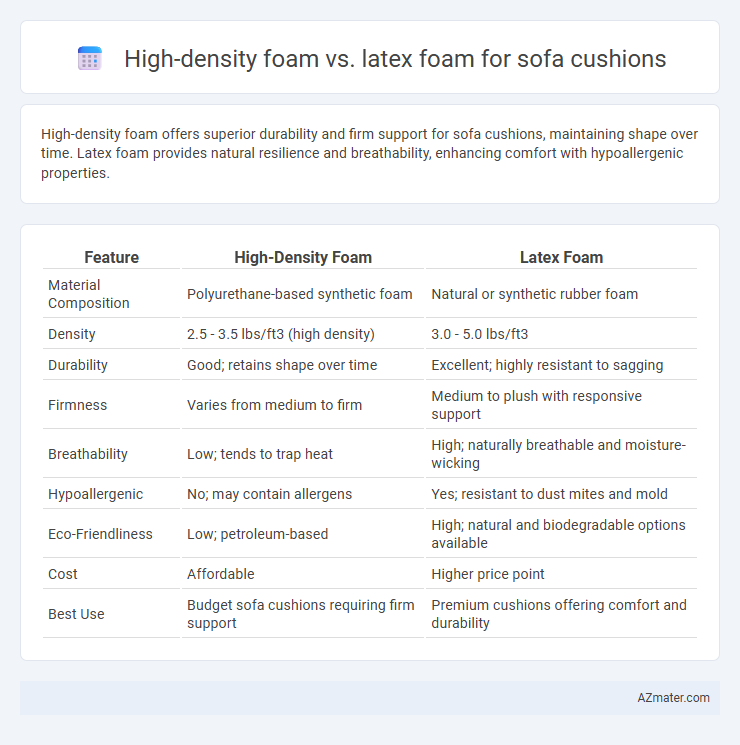High-density foam offers superior durability and firm support for sofa cushions, maintaining shape over time. Latex foam provides natural resilience and breathability, enhancing comfort with hypoallergenic properties.
Table of Comparison
| Feature | High-Density Foam | Latex Foam |
|---|---|---|
| Material Composition | Polyurethane-based synthetic foam | Natural or synthetic rubber foam |
| Density | 2.5 - 3.5 lbs/ft3 (high density) | 3.0 - 5.0 lbs/ft3 |
| Durability | Good; retains shape over time | Excellent; highly resistant to sagging |
| Firmness | Varies from medium to firm | Medium to plush with responsive support |
| Breathability | Low; tends to trap heat | High; naturally breathable and moisture-wicking |
| Hypoallergenic | No; may contain allergens | Yes; resistant to dust mites and mold |
| Eco-Friendliness | Low; petroleum-based | High; natural and biodegradable options available |
| Cost | Affordable | Higher price point |
| Best Use | Budget sofa cushions requiring firm support | Premium cushions offering comfort and durability |
Introduction to Sofa Cushion Materials
High-density foam and latex foam are two popular materials used in sofa cushions, each offering unique benefits. High-density foam provides firm support and durability, maintaining shape over time and ideal for those seeking resilience in seating. Latex foam offers natural elasticity and breathability, enhancing comfort and providing hypoallergenic properties perfect for sensitive users.
What is High-Density Foam?
High-density foam for sofa cushions is a durable material characterized by its high weight per cubic foot, typically ranging from 1.8 to 2.5 pounds, offering superior support and longevity compared to lower density foams. It maintains its shape and firmness over time, making it ideal for heavy-use furniture like sofas and sectionals. Unlike latex foam, high-density foam does not naturally resist allergens or moisture but provides excellent structural stability and cost efficiency.
What is Latex Foam?
Latex foam, derived from natural or synthetic rubber, offers exceptional resilience, breathability, and hypoallergenic properties, making it an ideal choice for sofa cushions. Unlike high-density foam, latex foam provides consistent support and retains its shape longer due to its inherent elasticity and open-cell structure. This natural material also enhances comfort by promoting airflow, reducing heat retention, and resisting dust mites and mold.
Durability Comparison: High-Density Foam vs Latex
High-density foam offers excellent durability with strong resistance to wear and sagging, typically lasting around 5 to 8 years under regular use. Latex foam surpasses high-density foam in durability, often maintaining firmness and shape for over 10 years due to its natural resilience and elasticity. Both materials provide robust support, but latex foam's superior longevity and resistance to compression make it the preferred choice for long-lasting sofa cushions.
Comfort and Support Differences
High-density foam offers firm support and retains its shape, making it ideal for individuals seeking consistent cushioning and durability in sofa cushions. Latex foam provides superior elasticity and responsiveness, delivering a softer, more natural comfort that contours to the body while maintaining support. The choice between high-density and latex foam impacts the overall seating experience, balancing long-lasting firmness with adaptive comfort.
Breathability and Temperature Regulation
High-density foam offers firm support and durability but tends to retain heat due to its dense structure, limiting breathability and causing potential discomfort during extended use. Latex foam stands out for superior breathability and natural temperature regulation, thanks to its open-cell structure and inherent resilience that promote airflow and dissipate heat efficiently. Choosing latex foam cushions enhances comfort by maintaining a cooler seating experience, while high-density foam prioritizes structural support with less effective moisture and heat management.
Allergen Resistance and Health Considerations
Latex foam offers superior allergen resistance due to its natural antimicrobial and hypoallergenic properties, effectively reducing dust mites and mold buildup, which benefits individuals with allergies or respiratory sensitivities. High-density foam, while durable and supportive, may off-gas volatile organic compounds (VOCs) during initial use, potentially affecting indoor air quality and sensitive users. Choosing latex foam cushions can enhance health outcomes by minimizing allergen exposure and promoting a cleaner living environment.
Cost and Value Analysis
High-density foam generally offers a more affordable option for sofa cushions, with prices significantly lower than natural latex foam, which tends to command a premium due to its durability and hypoallergenic properties. Latex foam cushions provide greater long-term value by maintaining shape and resilience for up to 15 years, compared to high-density foam that may begin to sag after 5 to 7 years. Cost analysis reveals high-density foam suits budget-conscious buyers seeking short to mid-term comfort, while latex foam represents a higher initial investment yielding extended lifespan and superior comfort.
Sustainability and Environmental Impact
High-density foam for sofa cushions offers durability and support but is typically derived from petrochemical sources, contributing to environmental pollution and non-biodegradability. In contrast, natural latex foam, sourced from rubber trees, provides a renewable and biodegradable option with lower carbon emissions during production, enhancing sustainability. Choosing latex foam can reduce the ecological footprint of furniture while delivering comparable comfort and longevity to high-density foam.
Which Foam is Best for Your Sofa?
High-density foam offers superior support and durability, making it an excellent choice for sofa cushions that require long-lasting firmness and shape retention. Latex foam provides natural resilience, excellent breathability, and hypoallergenic properties, ideal for those seeking eco-friendly comfort and pressure relief. Choosing the best foam for your sofa depends on your preference for firmness and sustainability, with high-density foam excelling in support and latex foam in comfort and environmental benefits.

Infographic: High-density foam vs Latex foam for Sofa cushion
 azmater.com
azmater.com